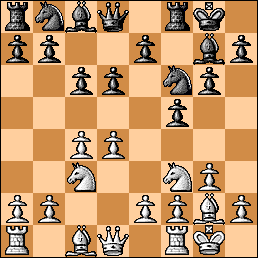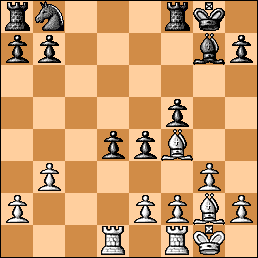National Open, Las Vegas, NV 2007. Round 4.
IM M. Ginsburg – WFM Y. Cardona (2270).
1. Nf3 f5?! An inaccuracy on the first move! To get to a Leningrad Dutch, much more circumspect is 1…g6 2. c4 and only now 2….f5 to avoid a nasty pitfall in this particular move order.
The problem here is that white has the surprisingly strong 2. d3! as demonstrated by GM Magnus Carlsen recently in a crushing win versus veteran Russian GM Sergei Dolmatov. As a New In Chess Secrets of Opening Surprises (SOS) book analysis noted, “this move argues that 1…f5 is weakening.” So it does! That game went 2…d6 3. e4 e5 4. Nc3 Nc6 5. exf5 Bxf5 6. d4! and white had an obvious plus. After 2. d3, black is not having any fun at all. Why didn’t I play it? I knew about it, but didn’t really remember how the Carlsen game went. Still, 2. d3! is strongest and I should have played it.
Side note. There is another attempt for white – in the 1980s and 1990s, GM Michael Rohde revived the Lisitsin Gambit (2. e4 fxe4 3. Ng5) with success but in the intervening years, methods were found by black to combat that try. Nevertheless, 2. e4 is exceedingly dangerous and black has to be well prepared for it. This is moot, though, given the strength of the apparently modest 2. d3!
In the game, I played the insipid 2. g3?! and play reverted back to the Leningrad proper.
2…Nf6 3. Bg2 g6 4. O-O Bg7 5. c4 O-O 6. Nc3 d6 7. d4 c6
One of the main lines of the Leningrad. Another move here, 7…Qe8 (A favorite of GM Malaniuk), is dealt with in a separate installment. I have had experiences with 7….Qe8 going back to a tussle with Bareev, Naestved, Denmark, 1988. For the time being, we will note that 7…Qe8 8. d5!? is a logical move. See Ginsburg-Sarkar, US Championship 2006, in which white was much better but let black escape with a draw.
8. d5! The best reaction. MG Postscript 6/16/08: Korchnoi’s 8. Qb3! is exceedingly dangerous.
8…e5 Not the only move, but a popular choice. On other moves, white likely follows up with the natural centralizing Nf3-d4. There is an ICC maniac who insists on playing 8…c5? here giving himself a huge hole on e6 but we can’t go that far afield.
9. dxe6 e.p. Bxe6 10. b3 Ne4?! The move 10…Na6! is much more reliable and leaves white with a small plus. Dutch IM Helmut Cardon held a draw vs me in a tournament in Eeklo, Belgium in the 1985 with this slow but solid enough way of playing. The text has been known to be dubious for some time.
11. Nxe4 fxe4! (11…Bxa1? is far too risky although it has been seen in a handful of games in practice. White has won model games after both 12. Qxd6, with monstrous ending compensation, and also 12. Nxd6, with monstrous middlegame compensation. The only weak move after 11…Bxa1 is the optically strong but totally ineffective 12. Neg5? – strange but true). I wrote an entire article on this subline which subscribers can access. You will need a subscriber user and password to access this specialized article.
12. Nd4 Bf5 Well, black’s position isn’t so bad here. She avoided the weak material grab and is playing for solidity.
13. Bf4 White makes up his mind to pressure the weak d6 pawn. I am not sure how great this move is, because the black d-pawn can move!
13…d5 14. cxd5 Qxd5! White had not really reckoned on this method of play. Black retains excellent defensive chances.
15. Nxf5 gxf5 16. Qxd5 cxd5 As you might guess, white has achieved very little by giving black a very nice pawn formation with his last few ineffective moves. The combination of white’s 15th and 16th should be awarded a collective “?!” symbol.
17. Rad1 d4 The truth dawns that black has fully equalized. This doesn’t mean the end of the game though – both sides have resources and the position is sharp with “mutual chances” as they say in wise textbooks.
18. g4 When in doubt, do something to break up a pawn formation. 18…Nc6! The right reaction. It would be naive to hope for the weak 18…fxg4? 19. Bxe4 hitting b7 thus giving black no time to take the loose bishop on f4.
19. e3 Waiting. 19…Rae8! Protecting the soon to be weak pawn on e4.
20. gxf5 Rxf5 Now it’s time for white to do something mysterious to confuse the issue. In his heyday, GM Sammy Reshevsky was a great maestro of the pseudo-constructive move – the opponent often simply misconstrued his (non-) intentions and promptly went wrong. White’s next move is a good example of a pseudo-constructive move that gives black some possible noose.
21. Kh1! There it is! This move, threatening absolutely nothing, gives black the option of potentially going wrong.
21…Nb4(?!) This move isn’t bad by itself, but it was not necessary. White really wasn’t doing much.
22. Bh3 Rxf4?! The variation 22…Rf7 23. Bg4! (idea of Bg4-h5) is annoying for black but should be considered. The text, creating what looks like an unstoppable passed pawn that is barreling ahead to a touchdown, is dealt with by some suprising long-range bishop maneuvers.
23. exf4 e3 24. fxe3 dxe3 25. Bd7! I am fairly sure black overlooked this in her calculations when she decided on her 22nd move.
25…Re7 What else? 26. Bb5! This switchback is suddenly decisive. 26…e2 fails to 27. Rd8+ so white remains solid material up. Nevertheless, the ending conversion requires careful technique.
26…Nxa2 Black might as well grab a pawn for her troubles.
27. Bc4+ Kf8 28. Rd8+! When material up, it’s always good to simplify to reduce the opoonent’s counterchances.
28…Re8 29. Rxe8+ Kxe8
30. Kg2 The king should always be used in the ending particularly when an enemy passed pawn needs to be held at bay. After the king is centralized, white can proceed on the kingside.
30…Nc3 31. Kf3 Bd4 Black’s knight and bishop form an effective team. Time to formulate an effective plan for white that takes into account black’s easy to fathom counterplay involving rushing the a- and b- pawns up.
32. Bd3 Getting out of the way of …b7-b5 and hitting the pawn on h7. 32…b5! Excellent play. Black must not hesitate to mobilize the queenside pawns. White doesn’t really have time to take on h7 (yet) and so activates the rook first.
33. Rg1! Kd7! The best chance. Black’s king rushes to assist the mobile queenside pawn duo. 34. Rg5! This is the winning idea. Using the rook laterally not only helps to hold up black, it also helps to usher the f-pawn ahead. 34…Kc6 35. Rh5! a5
36. f5 White figured out that he is a little faster in this race thanks to a tactical trick.
36… a4 37. bxa4 bxa4 38. f6! Kd6 Clearly, 38…Bxf6 39. Rh6 Nd5 40. Be4, winning a piece via the multiple pins, is not playable for black. This is the tactical motif that forces black’s king to run back, but it’s met by a completely bone-crushing move.
39. Rf5! Not super difficult but instructive. Placing the rook behind the passed pawn wins a piece and the game. White’s play in this phase was very accurate, not giving black any chances at all. 39…a3 40. f7 Bg7 41. f8=Q Bxf8 Black could have resigned here.
42. Rxf8 Kc5 43. Bxh7 Now is the time to capture on h7, since on g8 the bishop fulfills key defensive duties and the white h-pawn is ready to run.
43…e2 44. Kf2 Kc4 45. Ra8 Rooks behind passed pawns. 45…Kb3 46. Bg8+ Kc2 47. Ke1 Not letting black’s king close to the e-pawn. 47…Kb2 48. h4
Nothing can stop the h-pawn so black resigned. 1-0









